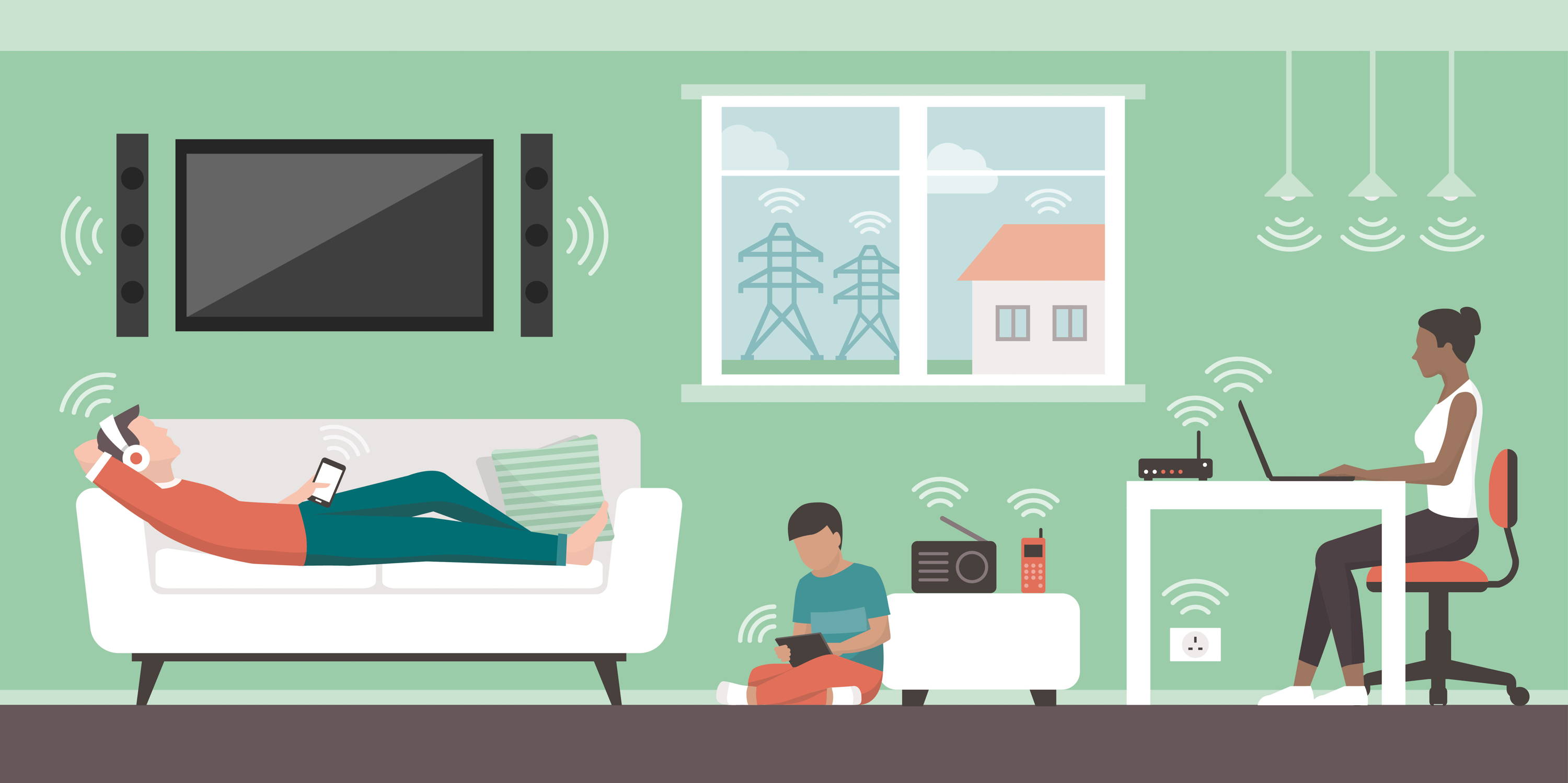Are EMFs Making You Sick? – A Nutrient Driven Detox May Help
Are EMFs Making You Sick? – A Nutrient Driven Detox May Help
In our modern, technology-centered world, we are surrounded by electromagnetic fields (EMFs). These fields are generated by the many electronic devices we engage with daily including our cell phones, home appliances, WiFi systems, and power tools. While these invisible electromagnetic waves are generally considered safe and make our lives more convenient in many ways, not all exposure is benign, and some individuals will experience severe adverse reactions to the radiation and develop a condition known as electromagnetic hypersensitivity syndrome (EHS).
EHS – A Modern Day Neurological Phenomenon
Prevalence of EHS was relatively low up until the early 1980s, but in the last few decades with the increases in our overall EMF exposure, it is estimated that about 10% of the population may be experiencing severe symptoms associated with this syndrome and as many as 30% may be dealing at least a mild form of sensitivity issues.1 Although EHS is characterized by a variety of non-specific symptoms, some of the more common symptoms include skin issues, fatigue, nausea, heart palpitations, digestive disturbances, and dizziness.
Common Symptoms of EHS2,3
- Skin – Tingling, Burning, rash
- Fatigue
- Difficulty Concentrating
- Heart Palpitations
- Nausea
- Depression
- Dizziness
- Digestive Changes
- Headache
- Sleep disturbance
- Tinnitus
- Vertigo
- Memory Loss
- Chest pain
- Infertility
- Vision Issues
This planet, and the biological systems within it, were not designed to be constantly inundated with elevated levels of toxic electromagnetic radiation. As levels continue to rise, so will the prevalence of EHS putting more of us at risk of developing other chronic diseases including heart disease, cancer, and autoimmune disorders. In general, those suffering with malnutrition, chronic inflammation, antioxidant depletion, and/or a history of cardiovascular disease tend to have the greatest risk of suffering damage and disease from exposure to EMFs.4,5
A Natural Approach to EHS
Most people rely on pharmaceuticals to address debilitating symptoms of EHS but over the last few years, reliance on pharma-derived products to manage health has drastically declined and today most people are looking for safer, alternative means to manage their issues.
The simplest way to address electromagnetic sensitivity is to practice mindful habits that minimize unnecessary exposure. Examples include limiting screen time, using shielding devices, and creating EMF-free zones in your living spaces. Another important step is maintaining a balanced lifestyle that includes a nutritious diet, regular exercise, and proper hydration to support overall well-being.
Specifically incorporating nutrients that stimulate your body’s natural detoxification pathways, boost antioxidant concentrations, and reduce systemic inflammation, may present a promising natural avenue to prevent and manage the toxic effects of EMF exposure.
Below are 5 examples of key nutrients that when optimized in our bodies, can help strengthen our systems against the toxic effects of EMF along with many other chronic disorders and diseases linked to their depletion like autoimmune disorders, heart disease, diabetes, and cancer.6,7,8,9
Vitamin D – This essential nutrient provides a variety of vital benefits that can help to reduce the negative effects of EMF exposure. In addition to its potent antioxidant and anti-inflammatory action, Vitamin D is essential to bone health, and provides support to the cardiovascular and immune systems. It has also been shown to play a role in regulating mood and reducing depression risks. In addition to supplementation, daily sun exposure, and dietary sources like fatty fish, eggs, cheese, and milk are great options to help ensure adequate levels of Vitamin D.10,11
Vitamin C – This vital nutrient is a powerful antioxidant capable of neutralizing damaging free radicals, which become elevated in the presence of excess EMF. This capacity to scavenge damaging free radicals makes it potentially effective at resisting damaging effects of EMF exposure. It is also known to play a crucial role in immune function and cardiovascular health. A dietary intake of a wide variety of fruits and vegetables are an excellent way to intake Vitamin C, but supplementation may still be necessary in some individuals to maintain healthy levels.12,13
EGCG – EGCG is a plant pigment found most prevalently in green teas and in smaller quantities in some fruits, nuts, and other types of teas. It is best known for its antioxidant and anti-inflammatory properties making it an excellent candidate for resisting EMF damage.14 Research shows that EGCG has numerous health benefits due to its ability to protect cells from damaging free radicals including reducing the risk of autoimmune disorder, cancer, diabetes, and COVID-19.15,16
Zinc – This nutrient has been shown to ease the adverse effects of radiation on the body including EMF-induced oxidation through its potent antioxidant effects. Zinc also has significant anti-inflammatory effects by helping reduce inflammatory molecules that may contribute to EHS symptoms.17,18
Cysteine – This amino acid offers several potential health benefits including antioxidant properties and detoxification both essential to minimizing EMF sensitivity. It also plays a role in supporting mental health and the respiratory and cardiovascular systems. In supplement formulations cysteine is best taken in the form of N-Acetyl-Cysteine or NAC, and dietary sources include a variety of foods like garlic, beef, whole grains, and poultry products.19
For individuals experiencing EMF sensitivity, a holistic approach may be the safest, most effective way to manage your symptoms. By supporting the body's natural healing and detoxification pathways, these nutrients may help boost antioxidant pathways, reduce inflammation, and alleviate symptoms associated with electromagnetic sensitivity.
To better assure you are meeting your daily needs of these essential nutrients regular supplementation may be best. Fortunately, Dr. Zelenko developed a formula featuring all 5 of these beneficial nutrients called Z-Dtox. He specifically selected these nutrients for their natural ability to support the immune system and resist environmental toxic influence on the body, such as that done by EMFs. The combination of Vitamin D, Vitamin C, Zinc, NAC, and EGCG create a potent formula that can act as an effective, natural solution to electromagnetic sensitivity and associated EHS.
References:
-
Bevington, M. (2019, January 18). The Prevalence of People with Restricted Access to Work in Manmade Electromagnetic Environments. Journal of Environment and Health Science, 5. Retrieved from: https://doi.org/10.15436/2378-6841.19.2402
-
Mallery-Blythe, E. (2021). Electromagnetic Hypersensitivity (EHS). Physicians’ Health Initiative for Radiation and Environment. Retrieved from: https://phiremedical.org/electromagnetic-hypersensitivity-ehs/
-
DeMajistre, A. (2023, June 14). Your Cellphone and Other EMF Devices May Be Harming Your Heart. Epoch Health. Retrieved from: https://www.theepochtimes.com/health/your-cell-phone-and-other-emf-devices-may-be-harming-your-heart-5319519
-
Belpomme, D., Caccamo, D., & Irigaray, P. (2018, October). Oxidative stress in electrohypersensitvity self-reporting patients: Results of a prospective in vivo investigation with comprehensive molecular analysis. International Journal of Molecular Medicine, 42(4): 1885-1898. Retrieved from: https://doi.org/10.3892%2Fijmm.2018.3774
-
Mevissen, M., & Schuermann, D. (2021, April). Manmade Electromagnetic Fields and Oxidative Stress – Biological Effects and Consequences for Health. International Journal of Molecular Sciences, 22(7): 3772. Retrieved from: https://doi.org/10.3390%2Fijms22073772
-
Meydani, S., Pae, M., Wang, J., & Wu, D. (2011, October 14). Green tea EGCG, T cells, and T cell-mediated autoimmune diseases. Molecular Aspects of Medicine, 33(1): 107-118. Retrieved from: https://doi.org/10.1016/j.mam.2011.10.001
-
Moxley, E. (2023, March 23). Cardiovascular Health Through Vitamin C Intake. Preventative Cardiovascular Nurses Association. Retrieved from: https://pcna.net/cardiovascular-health-through-vitamin-c-intake/
-
Jain, S. K. (2012, August). L-cysteine supplementation as an adjuvant therapy for type-2 diabetes. Canadian Journal of Physiology and Pharmacology, 90(8): 1061-1064. Retrieved from: https://doi.org/10.1139/y2012-08
-
Beck, F. W., Kucuk, O., Prasad, A. S., & Snell, D. C. (2009). Zinc in cancer prevention. Nutrition and Cancer, 61(6): 879-887. Retrieved from: https://doi.org/10.1080/01635580903285122
-
Devje, S. (2023, February 6). Vitamin D Benefits. Healthline. Retrieved from: https://www.healthline.com/health/food-nutrition/benefits-vitamin-d
-
Mayo Clinic Staff. (2023, August 10). Vitamin D. Mayo Clinic. Retrieved from: https://www.mayoclinic.org/drugs-supplements-vitamin-d/art-20363792
-
Cui, Q., & et al. (2022, August). Vascular benefits of vitamin C supplementation against fine particulate air pollution in healthy adults: A double-blind randomized crossover trial. Ecotoxicology and Environmental Safety. Retrieved from: https://doi.org/10.1016/j.ecoenv.2022.113735
-
Mortazavi, S. M., & et al. (2016, September). Evaluation of the Protective Role of Vitamin C on the Metabloic and Enzymatic Activities of the Liver in the Male Rats After Exposure to 2.45 GHz of Wi-Fi Routers. Journal of Biomedical Physics & Engineering, 6(3): 157-164. Retrieved from: https://pubmed.ncbi.nlm.nih.gov/27853723
-
Ahammed, G. J., & et al. (2023, May). Epigallocatechin-3-Gallate (EGCG): A unique secondary metabolite with diverse roles in plant-environment interaction. Botany, 209. Retrieved from: https://doi.org/10.1016/j.envexpbot.2023.105299
-
Poteet, M. (2020, March 16). Your Guide to eGCG (Epigallocatechin-3-gallate). Compounding Pharmacy of America. Retrieved from: https://compoundingrxusa.com/blog/your-guide-to-egcg-epigallocatechin-3-gallate/
-
Bertoldi, M., & et al. (2020, July). Protective Effect of Epigallocatechin-3-Gallate (EGCG) in Diseases with Uncontrolled Immune Activation: Could Such a Scenario Be Helpful to Counteract COVID-19? International Journal of Molecular Sciences, 21(14): 5171. Retrieved from: https://doi.org/10.3390%2Fijms21145171.
-
Amin, A., I., & et al. (2016, June 15). Thyroid Hormone Indices in Computer Workers with Emphasis on the Role of Zinc Supplementation. Open Access Macedonian Journal of Medical Sciences, 4(2): 296-301. Retrieved from: https://doi.org/10.3889%2Foamjms.2016.041
-
Olechnowicz, J., & et al. (2018). Zinc status is associated with inflammation, oxidative stress, lipid, and glucose metabolism. Journal of Physiological Sciences, 68. Retrieved from: https://doi.org/10.1007/s12576-017-0571-7
-
Cysteine. (n.d.). Mount Sinai. Retrieved from: https://www.mountsinai.org/health-library/supplement/cysteine


Leave a comment